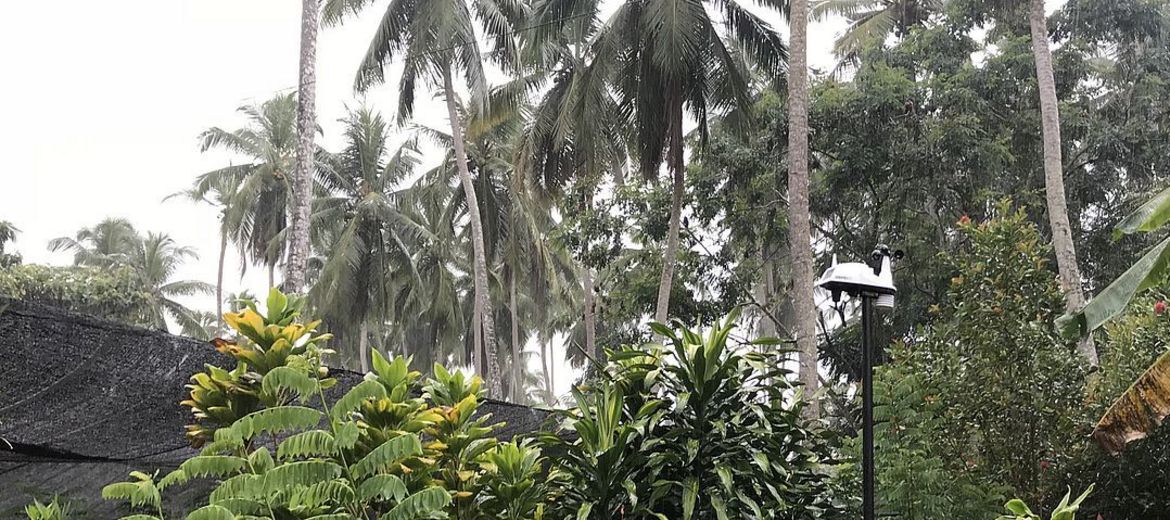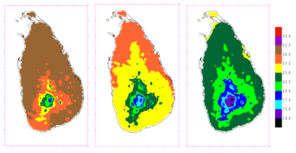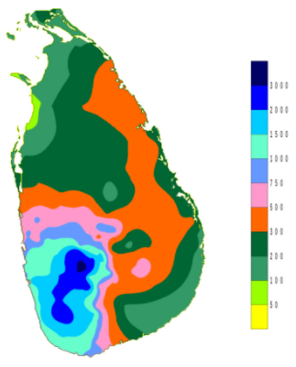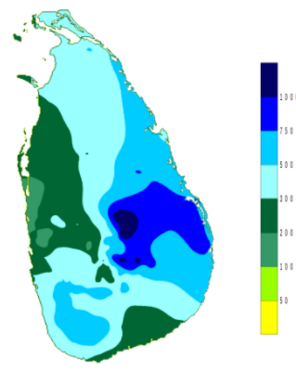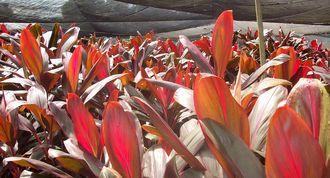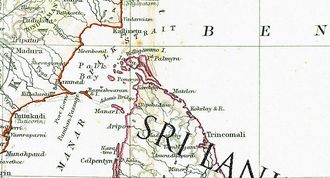Climate
ACTUAL CLIMATICAL CONDITION ON OUR FARMS
LENA FARM
Weatherstation
HANDESSA FARM
Weatherstation
ATTANAGALLA FARM
Weatherstation
CLIMATE FACTS SRI LANKA
source: www.meteo.gov.lk
Due to the location of Sri Lanka, within the tropics between 5° 55' to 9° 51' North latitude and
between 79° 42' to 81° 53' East longitude, the climate of the island is characterized as tropical.
TOPOGRAPHY
The central part of the southern half of the island is mountainous with heights more then 2500m above sea level. The core regions of the central highlands contain many complex topographical features such as ridges, peaks, plateaus, basins, valleys and escarpments. The remainder of the island is practically flat except for several small hills that rise abruptly in the lowlands. These topographical features strongly affect the spatial patterns of winds, seasonal rainfall, temperature, relative humidity and other climatic elements, particularly during the monsoon season.source Departement of Meteorology Sri Lanka
RAINFALL
Rainfall in Sri Lanka has multiple origins. Monsoonal, Convectional and expressional rain accounts for a major share of the annual rainfall. The mean annual rainfall varies from under 900mm in the driest parts (southeastern and northwestern) to over 5000mm in the wettest parts (western slopes of the central highlands).
The rainfall pattern is influenced by the monsoon winds of the Indian Ocean and Bay of Bengal and is marked by four seasons. The first is from mid-May to October, when winds originate in the southwest, bringing moisture from the Indian Ocean. When these winds encounter the slopes of the Central Highlands, they unload heavy rains on the mountain slopes and the southwestern sector of the island. Some of the windward slopes receive up to 250 centimeters of rain per month, but the leeward slopes in the east and northeast receive little rain. The second season occurs in October and November, the intermonsoonal months. During this season, periodic squalls occur and sometimes tropical cyclones bring overcast skies and rains to the southwest, northeast, and eastern parts of the island. During the third season, December to March, monsoon winds come from the northeast, bringing moisture from the Bay of Bengal. The northeastern slopes of the mountains may be inundated with up to 125 centimeters of rain during these months. Another intermonsoonal period occurs from March until mid-May, with light, variable winds and evening thundershowers.
Humidity is typically higher in the southwest and mountainous areas and depends on the seasonal patterns of rainfall. At Colombo, for example, daytime humidity stays above 70 percent all year, rising to almost 90 percent during the monsoon season in June. Anuradhapura experiences a daytime low of 60 percent during the intermonsoonal month of March, but a high of 79 percent during the November and December rains. In the highlands, Kandy's daytime humidity usually ranges between 70 and 79 percent.
TEMPERATURE
Regional differences observed in air temperature over sri lanka are mainly due to altitude, rather than to latitude. The mean monthly temperatures differs slightly depending on the seasonal movement of the sun, with some modified influence caused by rainfall. The mean annual temperature in Sri Lanka manifests largely homogeneous temperatures in the low lands and rapidly decreasing temperatures in the highlands. In the lowlands, up to and altitude of 100 m to 150 m, the mean annual temperature various between
26.5 °C to 28.5 °C, with an annual temperature of 27.5 °C. In the highlands, the temperature falls quickly as the altitude increases. The mean annual temperature of Nuwaraeliya, at 1800 m sea level, is 15.9 °C. The coldest month with respect to mean monthly temperature is generally January, and the warmest months are April and August.The mean annual temperature varies from 27°C in the coastal lowlands to 16°C at NuwaraEliya, in the central highlands (1900m above mean sea level). This unique feature allows a very wide range of plants to be grown on the island.
CLIMATIC SEASONS
The Climate of Sri Lanka is dominated by the above mentioned topographical features of the country and the Southwest and Northeast monsoons regional scale wind regimes. The Climate experienced during 12 months period in Sri Lanka can be characterized in to 4 climate seasons as follows.
First Inter Monsoon Season (March - April)
Warm and uncomfortable conditions, with thunderstorm-type rain, particularly during the afternoon or evening, are the typical weather conditions during this season. The distribution of rainfall during this period shows that the entire South-western sector at the hill country receiving 250 mm of rainfall, with localize area on the South-western slops experiencing rainfall in excess of 700 mm (Keragala 771 mm). Over most parts of the island, the amount of rainfall varies between 100 and 250 mm, the notable exception being the Northern Jaffna Peninsula (Jaffna- 78 mm, Elephant pass- 83 mm).
Southwest Monsoon YALA Season (May to September)
Windy weather during this monsoon eases off the warmth that prevailed during the 1st Inter monsoon season. Southwest monsoon rains are experience at any times of the day and night, some times intermittently mainly in the Southwestern part of the country. Amount of rainfall during this season varies from about 100 mm to over 3000 mm. The highest rainfall received in the mid-elevations of the western slops (Ginigathhena- 3267 mm, Watawala- 3252 mm, Norton- 3121 mm). Rainfall decreases rapidly from these maximum regions towards the higher elevation, an in Nuwara-eliya drops to 853 mm. The variation towards the Southwestern coastal area is less rapid, with the Southwestern coastal belt experiencing between 1000 mm to 1600 mm of rain during this 5 month long period. Lowest figures are recorded from Northern and Southeastern regions.
Second Inter Monsoon Season (October to November)
The thunderstorm-type of rain, particularly during the afternoon or evening, is the typical climate during this season. But unlike in the Intermonsoon season, the influence of weather system like depression and cyclones in the Bay of Bengal is common during the second Intermonsoon season. Under such conditions, the whole country experiences strong winds with wide spread rain, sometimes leading to floods and landslides. The second Intermonsoon period of October – November is the period with the most evenly balanced distribution of rainfall over Sri Lanka. Almost the entire island receives in excess of 400 mm of rain during this season, with the Southwestern slops receiving higher rainfall in the range 750mm to 1200 mm (Weweltalawa Estate in Yatiyantota recording 1219 mm)
Northeast Monsoon MAHA Season (December to February)
The dry and cold wind blowing from the Indian land-mass will establish a comparatively cool, but dry weather over many parts making the surrounding pleasant and comfortable weather except for some rather cold morning hours. Cloud-free skies provide days full of sunshine and pleasant and cool night. During this period, the highest rainfall figures are recorded in the North, Eastern slopes of the hill country and the Eastern slopes of the Knuckles/Rangala range. The maximum rainfall is experience at Kobonella estate (1281 mm), and the minimum is in the Western coastal area around Puttalam (Chilaw- 177 mm) during this period
As you can see this climates makes Sri Lanka a paradise for Tropical Plants checkout our ASSORTMENT DATABASE to learn more about whats growing here.


